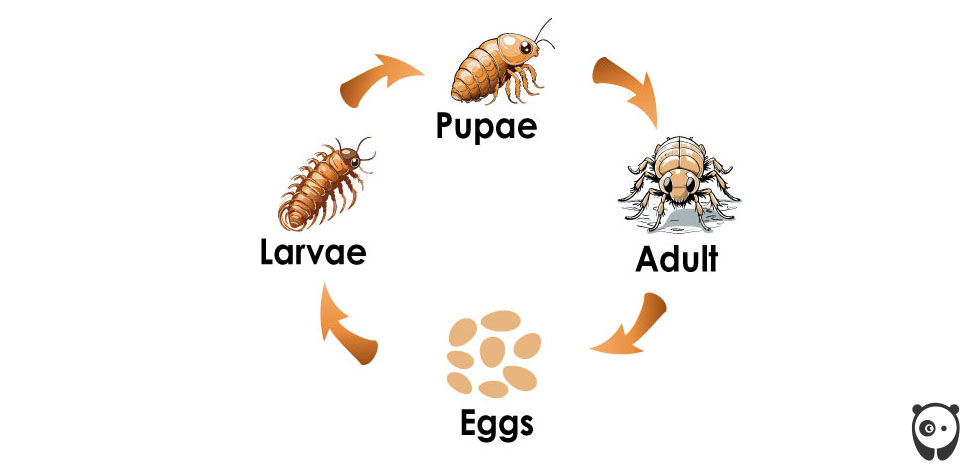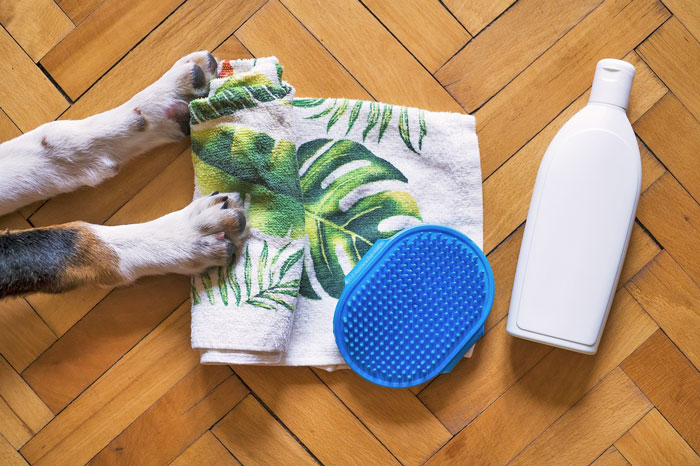As the spring season starts & the sun makes our backyards warmer, pet owners look forward to spending more time outside with their furry friends. However, this pleasant weather also signals a less welcome phenomenon – the hatching of flea eggs. And these turn our backyards into breeding grounds for these tiny, resilient pests. Fleas can multiply really fast. A single flea can lead to a huge problem before you know it. And, their tiny size and the hardiness of their eggs often leave pet parents unaware until it’s too late. Just imagine, in the cozy warmth of your home, flea eggs find the perfect haven to thrive – making them a formidable foe in pet care. What’s more? flea eggs can be hard to get rid of because they can resist many usual treatments. However, dealing with these small enemies isn’t as hard as it might seem.
HighlightsFlea eggs look like tiny grains of rice, hard to see due to their size (0.5 mm) and can be white to see-through.A single female flea can lay over 2,000 eggs in her lifetime, spreading them across carpets, bedding, and grass.Effective flea egg elimination involves using flea shampoos, flea combs, topical medications, and household cleaning.Only 5% of fleas are on pets; the rest are in the environment, highlighting the importance of treating both pets and home.
So keep reading to learn about the best ways to fight off the eggs of these annoying pests & keep your pets healthy and happy.
The information provided herein is for informational purposes only. Please refer to ourdisclaimerfor more details..
Table of ContentsUnderstanding the Flea Life CycleStage 1: Flea EggsStage 2: Flea LarvaeStage 3: Flea PupaeStage 4: Adult FleasWhat Do Flea Eggs Look Like? Flea Eggs vs Dandruff vs Flea DirtHow To Identify Flea Eggs on Dogs and Cats?How To Get Rid of Flea Eggs?1. Removing Flea Eggs From Pets2. Killing Flea Eggs in Your HomeConclusion
Understanding the Flea Life Cycle

When it comes to flea infestation, a comprehensive understanding of their life cycle is vital for the effective eradication and prevention of fleas and flea eggs. Fleas, which can be a big problem for your animals, go through four main stages in their life. And each stage needs different ways to handle them. Let’s dive into theirlife cycle stages:
Stage 1: Flea Eggs
It all starts when female fleas lay eggs after they’ve had a meal of your pet’s blood. Contrary to common belief, human blood isn’t suitable for flea reproduction – thus, exclusively flea bites animals like dogs and cats. And, after eating, a female flea can lay over 2,000 eggs in her lifetime (up to 40 to 50 eggs per day), which is about one to two months. These eggs get laid in your pet’s fur but quickly spread around your home, like on:
Stage 2: Flea Larvae
Flea eggs hatch into larvae in about 1 to 10 days, depending on how warm and humid it is. And they like it best at75 to 85 degrees Fahrenheitwith about 50 percent humidity. Larvae hide from light and stay in dark, damp places like carpets or under furniture. They eat organic stuff, including the flea feces & can grow up to 5mm long.
Stage 3: Flea Pupae
Stage 4: Adult Fleas
Adult fleas come out of the cocoons and need to feed on a host quickly. Once they find a host, like your pet, theystart feeding and laying eggs. Treating your pets well is important to control flea numbers – as adult fleas spend most of their time on animals. And so, the cycle starts again with these new fleas laying more eggs.
The Centers for Disease Control points out that a flea’s growth from egg to adult depends a lot on the weather. Fleas do well in warm places and might not survive cold weather. In the right conditions, a flea can go from egg to adult in just two weeks. Surprisingly, only 5% of fleas are actually on your pet; the rest are spread out in your home & yard.
What Do Flea Eggs Look Like? Flea Eggs vs Dandruff vs Flea Dirt
Image credits:

Knowing what flea eggs look like is key to dealing with flea problems in pets. These eggs are super tiny, almost like tiny grains of rice. They’re oval-shaped and usually no bigger than 0.5 mm, about the size of a grain of sand or salt. And, their color can be bright white to off-white or even see-through – which makes them tough to see on light surfaces.
Spotting flea eggs is a big step in dealing with fleas, a major part of keeping your pets and home free from fleas.
How To Identify Flea Eggs on Dogs and Cats?
Finding flea eggs on your pet can be tricky, especially if they have light fur. Since flea eggs fall off pets pretty easily, you usually won’t see many on your pet at once. But, there are ways to check for them.
Check these areas for eggs of fleas on your pet and also where your pet likes to relax – using the magnifying glass for a better look.
A flea comb is another essential tool if you suspect that your dog has fleas and fleas eggs. The comb’s teeth are really close together, perfect for catching those tiny white eggs. Be gentle but make sure to comb through all the fur so you can see the skin underneath. And it’s best to do this outside so you don’t end up spreading the eggs inside your house. While it might be a bit easier to comb flea eggs out of a cat’s softer fur, finding and getting them out of a dog’s coat can be more of a challenge.
How To Get Rid of Flea Eggs?
Image credits:mattycoulton

1. Removing Flea Eggs From Pets
Note:Remember, while this information is helpful in removing flea eggs from pets, it’s crucial to prioritize consulting your veterinarian. They can properly diagnose the severity of the infestation, recommend the safest and most effective treatment plan for your specific pet, and ensure their overall health and well-being throughout the process.
2. Killing Flea Eggs in Your Home
Removing flea eggs from your house takes a bit of work, but it’s doable with the right steps. Here’s how you can tackle the problem:
Staying consistent and thorough is the best way to get rid of flea eggs in your home. Regular cleaning, vacuuming, and using the right flea-control methods will help make sure your home is free of fleas.
Conclusion
Understanding and tackling flea eggs is paramount for every dog enthusiast and future dog owner. And, as we’ve talked about, removing these tiny pests isn’t easy. But with the right know-how and tools, you can keep your furry buddies & your home free from fleas. Remember, fleas aren’t just annoying; they can be harmful to your precious pets and mess with the peace of your home. By learning about how fleas live and grow and using the methods we’ve discussed – you’re taking a big step in being a responsible pet owner. The best ways to fight fleas are:
So stay on top of things, take action early, and make sure your dog lives in a safe, flea-free space. Your effort shows how much you care about your pet and your commitment to keeping your home happy & healthy.
Thanks! Check out the results:
2Kviews2Kviews
Pet Wellness